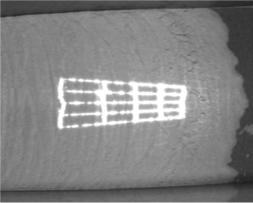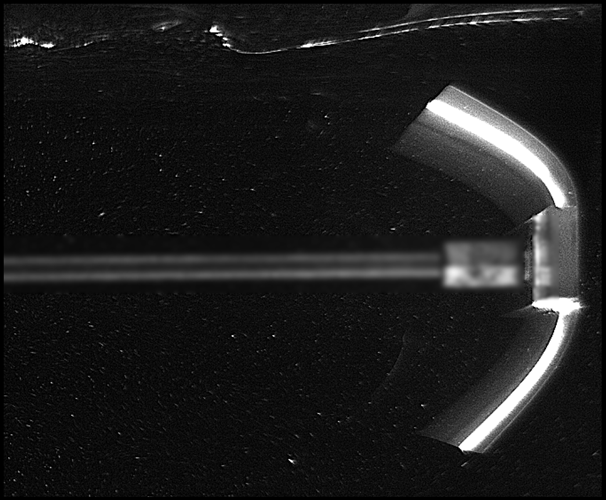Abstract: A theory of non-homogeneous turbulence is developed and applied to boundary-free shear flows. The theory introduces assumptions of inner and outer similarity for the non-homogeneity of two-point statistics, and predicts power-law scalings of second-order structure functions that have some similarities with but also some differences from Kolmogorov scalings. These scalings arise as a consequence of these assumptions, of the general interscale and interspace energy balance, and of an inner–outer equivalence hypothesis for turbulence dissipation. They reduce to the usual Kolmogorov scalings in stationary homogeneous turbulence. Comparisons with structure function data from three qualitatively different turbulent wakes provide support for the theory’s predictions but also raise new questions for future research.
Catégorie d'événements : Fluides, Thermique et Combustion
Séminaire – Mécanique des fluides et aéronautique dans la première moitié du 20e siècle : enjeux scientifiques, industriels et culturels François Charru
Mécanique des fluides et aéronautique dans la première moitié du 20e siècle : enjeux scientifiques, industriels et culturels
François Charru
Institut de mécanique des fluides de Toulouse – Université de Toulouse
L’aéronautique française a connu dans la première décennie du 20e siècle un essor fulgurant, porté par de généreux mécènes privés et par un enthousiasme populaire considérable. Mais cette aéronautique décline dans l’entre-deux-guerres, faute de savoir s’organiser en véritable industrie. Un ministère de l’Air est créé en 1928 afin de redresser la situation. Son énergique directeur technique, Albert Caquot, lance alors un ambitieux programme en faveur de la mécanique des fluides, avec la création de quatre instituts et cinq centres d’annexes d’enseignement — dont un à la faculté des sciences de Poitiers. Ce programme, par son ampleur et sa hauteur de vue, constitue une première politique nationale pour la recherche scientifique et préfigure la création ultérieure des grands organismes nationaux de recherche.
Du côté scientifique, la possibilité même de l’envol mécanique d’un « plus lourd que l’air » a longtemps divisé les savants, et l’évidence de sa réalisation par d’intrépides aventuriers suscite des controverses. La théorie de la couche limite de Ludwig Prandtl, à Göttingen, ne sera ainsi acceptée en Angleterre qu’au milieu des années 1920. Un autre domaine se développe alors en Allemagne et en Angleterre, en liaison avec la mécanique statistique : l’étude des écoulements turbulents. Comment les nouvelles théories, qui réconcilient l’hydraulique des ingénieurs avec la mécanique « rationnelle », ont-elles été reçues en France ? Quelles ont été les contributions françaises ? Quel a été l’effet des moyens considérables investis par le ministère de l’Air ? Le séminaire présentera cette histoire dans ses dimensions scientifiques, industrielles et culturelles, en y situant plus particulièrement la mécanique poitevine.
Webinaire – Theoretical and numerical analysis of the evaporation of mono- and multicomponent single fuel droplets_ _Alejandro Millán-Merino, Eduardo Fernández-Tarrazo and __Mario Sánchez-Sanz
Mario SANCHEZ SANZ
mssanz@ing.uc3m.es
Associate Professor
Fluid Mechanics Research Group
Universidad Carlos III de Madrid
_Title: Theoretical and numerical analysis of the evaporation of mono- and multicomponent single fuel droplets_
_Alejandro Millán-Merino, Eduardo Fernández-Tarrazo and __Mario Sánchez-Sanz _
Single fuel droplet vaporization, with special attention to the case of ethanol, is considered in this study. First, we showed, using an order-of-magnitude analysis and detailed unsteady simulations, that the commonly used quasi-steady assumption is not suitable for an accurate description of the liquid phase during the evaporation process. Second, we demonstrated that an increase in the relative importance of radiation explains the departures of the evaporation rate from the d2-law observed experimentally when sufficiently large droplets – initial radius above 0.25 mm – evaporated in ambient temperatures around 800 K. The multicomponent formulation included here, in which the physical properties of both liquid and gas phases depend on the concentration of the different species involved, was validated by comparing our numerical results with experimental data of ethanol, _n_-heptane, ethanol-water and _n_-dodecane-_n_-hexadecane droplets available in the literature. Because of its technological relevance, we dedicated special attention to the effect of the droplet water content and ambient humidity on the evaporation time of ethanol droplets. Our computations showed higher vaporization rates with increasing ambient humidity as a consequence of the extra heat generated during the condensation of moisture on the droplet surface.
Webinaire FTC: Using Scale Modelling to Assess the Prehistoric Acoustics of Stonehenge, Trevor Cox
With social rituals usually involving sound, an archaeological understanding of a site requires the acoustics to be assessed. This talk details how this can be done with acoustic scale models. Scale modelling is an established method in architectural acoustics, but it has not previously been applied to prehistoric monuments. The Stonehenge model described here allows the acoustics in the Late Neolithic and early Bronze Age to be quantified and the effects on musical sounds and speech to be inferred. It was found that the stone reflections create an average mid-frequency reverberation time of (0.64 ± 0.03) seconds and an amplification of (4.3 ± 0.9) dB for speech.
The model has a more accurate representation of the prehistoric geometry, giving a reverberation time that is significantly greater than that measured in the current ruin and a full-size concrete replica at Maryhill, USA. The amplification could have aided speech communication and the reverberation improved musical sounds. How Stonehenge was used is much debated, but these results show that sounds were improved within the circle compared to outside. Stonehenge had different configurations, especially in terms of the positions of the bluestones. However, this made inaudible changes to the acoustics, suggesting sound is unlikely to be the underlying motivation for the various designs.
Séminaire FTC: Rhéologie des matériaux granulaires cohésifs: Ecoulement de grains humides sur plan incliné, Stephanie Deboeuf
Stéphanie DEBOEUF de l’institut d’Alembert (Paris)
Présentera les écoulements multi-phasiques naturels ou industriels (glissements de terrain, coulées de boue, mélanges de poudres, …) montrent des propriétés rhéologiques non triviales, que je cherche à mieux comprendre grâce à des expériences modèles. Je présenterai nos travaux récents sur les matériaux granulaires humides en écoulement sur un plan incliné, dont la rhéologie, à mi-chemin entre celles des matériaux granulaires secs et des suspensions concentrées, est assez peu documentée.
Nos expériences révèlent des configurations d’écoulement stationnaire uniforme pour une large gamme de paramètres expérimentaux (angle de la pente, ouverture du silo, quantité de liquide). Un modèle rhéologique, associant le critère de limite de stabilité de Mohr-Coulomb et la rhéologie du mu(I) identifié pour les écoulements granulaires non cohésifs: tau = tau_c + mu(I) P, où tau_c et mu(I) sont respectivement la contrainte seuil de cohésion et le coefficient de frottement interne dépendant du nombre adimensionné inertiel I, est étudié. Ce modèle prédit bien nos mesures expérimentales, à condition … SUSPENS! …
Cela suggère de confronter nos données expérimentales aux différentes propositions faites dans la littérature pour unifier écoulements secs, cohésifs, en suspension, … par E. Guazzelli et al (2018), T. Vo et al (2020), S. Mandal et al (2020), …
Webinaire FTC: Internal wave crystals, Séverine Atis.
Geophysical fluids such as the ocean and atmosphere can be stratified: their density depends on the depth. As a consequence, they can host internal gravity waves that propagate in the bulk of the fluid and transport energy and momentum far from the surface. These waves can be carried over large distances, thereby influencing large-scale circulation patterns and climate. In the ocean, the interplay between heat diffusion and salt diffusion can lead to the formation of spatially periodic density profiles called thermohaline staircases. Drawing an analogy from electronic band structure of one-dimensional crystals, we show with laboratory experiments the existence of band gaps, ranges of frequencies over which the wave propagation is prohibited in the presence of a periodic stratification. We also demonstrate the existence of surface states arising at the boundary of the resulting internal wave crystal, and elucidate their relation with topological insulators. Our results suggest that periodic stratifications can profoundly affect internal wave dynamics in geophysical fluids ranging from the Arctic Ocean to giant planet interiors.
Soutenance de thèse de Mr Rodrigo VICENTE CRUZ
Soutenance de Thèse de Mlle Michelle NASSAR
Les dispositifs électriques, notamment embarqués, sont de plus en plus compacts et nécessitent toujours plus de puissance. Or, tous ces composants électriques produisent de la chaleur qu’il faut absolument évacuer pour maintenir un fonctionnement optimal. Dans cet objectif, l’équipe électrofluidodynamique de l’institut Pprime développe des systèmes électrohydrodynamiques (EHD) qui ont déjà montré de nombreux avantages pour les applications aussi bien spatiales que terrestres.
Pour fonctionner de façon optimale, les systèmes EHD utilisent des liquides diélectriques avec un impact écologique faible comme les Hydrofluoroethers (HFE) dont le comportement électrique est mal connu. L’objectif du travail réalisé dans cette thèse est de caractériser la variation des propriétés électriques des HFE 7000 et 7100 en fonction de la température. Plusieurs méthodes ont été employées pour analyser le comportement électrique en basse tension ; une première méthode conforme aux directives de la normes CEI 61620 puis une seconde basée sur la spectroscopie diélectrique. L’étude est ensuite élargie au comportement thermique sous haute tension. L’analyse des caractéristiques courant–tension permet de mettre en évidence les trois zones typiques de comportement : ohmique, quasi–ohmique et d’injection et ainsi de définir les limites des régimes de conduction et d’injection.
Cette partie haute tension aborde également, dans le respect la norme CEI 60156, le problème de la rigidité diélectrique des deux HFE à différentes températures en phase gazeuse et en phase liquide.
Enfin, une étude préliminaire novatrice sur l’effet Kerr dans le HFE–7100 est réalisée. Elle montre que cet effet électro–optique peut être utilisé pour l’étude du développement des couches chargées aux
interfaces HFE/électrodes. En conclusion, les résultats obtenus dans ce travail apportent une contribution à la compréhension du comportement électrique des HFE. Ceci est nécessaire pour améliorer et optimiser les performances des systèmes EHD fonctionnant avec ces liquides.
Webinaire FTC: Effect of free surface on the hydrodynamics of plates in cross-flow, Mr Sukruth Satheesh.
Effect of free surface on the hydrodynamics of plates in cross-flow
Cylinders and flat plates oriented normal to the flow are typical bluff bodies, characterized with large regions of separated flow and a significant pressure drag component. The study of forces generated by bluff bodies has been one of the oldest problems in fluid mechanics, studied initially using free streamline theory and the modified hodograph plane theory. These canonical bodies are also used extensively in several industrial sectors, ranging from oil & gas, transportation to energy. There is a good amount of literature on the interaction between cylinders and boundaries, but very little information is available related to the interaction between flat plates and deformable boundaries. This lack of information is even more apparent when plate aspect ratio is considered as well. With this in mind, this talk focuses on hydrodynamics of plates in cross-flow near the free surface over a range of aspect ratios, Reynolds numbers, and submergence depths. Later, a few strategies for drag control, namely structural flexibility and strategic porosity are also presented.
Webinaire FTC: HOW PLANTS AND TREES CAN INSPIRE US OR TALKING ABOUT PLANT BIOMECHANICS de Gustavo VARGAS-SILVA
Trees are the largest living beings that have ever lived on Earth, with more than one hundred meters high, masses of several thousand tons, and ages of several thousand years. In order to achieve this, among other functional conditions, trees must cope with all kinds of mechanical loads. On that line of thought, this lecture presents some of the most important strategies of growth, anatomy and morphology that plants and trees use, from a biomimetic approach, to meet structural requirements. The idea is to highlight how species of the plant kingdom can serve as biomechanic models in engineering, architecture and industrial design applications. Special emphasis will be placed on the relationship between the structure and function of some plant systems to study materials and technological solutions, or simply to wonder with the wisdom of nature.






